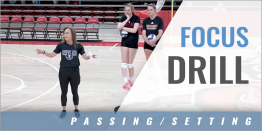|
By: Christy Johnson-Lynch, Head Women's Volleyball Coach - Iowa State University Originally Published in: Coaching Volleyball Magazine Provided By: AVCA
One of my favorite books on leadership is Good to Great by Jim Collins. In it, Collins describes the characteristics of companies and leaders that take a business from average to highly successful. Much of what he writes about can be related to teams and leading your players and staff. I found Collins' ideas on the personal qualities of the presidents and CEOs of great companies both surprising and fascinating. I assumed these men and women would have big personalities and big egos, that they would be the ones with the best-selling memoirs. Turns out the best leaders are often people we have never heard of. They quietly build their businesses with diligence and determination, and although they are incredibly ambitious, they always put the company before self. The same qualities that Collins discovered in successful CEOs can be found in exceptional setters. She doesn't have to be the loudest player on the court. The team does not have to revolve around her. In fact, the best setters I've coached were often humble and reserved, yet fiercely competitive. To quote Collins, "More plow horse than show horse." Of course, you might have a setter with a very dynamic personality who attacks every third ball and likes to run the show, and you can be successful with her as well. But don't overlook the setter that, while not particularly flashy or ostentatious, will quietly go about the business of winning matches. Helping your setter go from good to great is no easy process. It takes time, patience, and a lot of feedback; but, developing your setter is one of the most important things you can do to get your team to win at the highest level. I believe exceptional setters, no matter their style or personality, have several key qualities in common. Great Setters Have Great Feet This might seem like a no-brainer, but I challenge you to really take a look at your setter's feet. Great setters have very efficient footwork. They don't time the ball, they get to it quickly. We call it "beating the ball to the spot." Great footwork allows your setter to contact the ball high in the middle of the forehead every time. Beginning setters tend to make adjustments with their upper body which means they won't always contact the ball in the same spot. The best setters will get their feet under the ball every time so that their contact point is always the same. I also like for my setter to arrive to the ball with her right foot slightly in front of her left and transfer her weight onto her right as she sets. If she beats the ball to the spot, then she will be stopped upon contact, her hips will be under or slightly behind her shoulders (not in front of her shoulders as is common with younger setters), and she'll be able to transfer her weight through the set. One trick I have learned is to actually have my setter contact the ball over her right eye when she comes off the net. This will force her to get her feet all the way to the ball. If she stops short then she'll contact the ball over her left eye. Contacting over the right eye also makes it easier to transfer weight onto the right foot, and is especially important if you want your setter to set a quick set from off the net. It's tough to connect on a quick if your setter contacts the ball on her left side and is falling back. It's much easier to connect when she takes it on the right side and she is transferring her weight forward into the set. Great Setters Set Hittable Balls This is a term we use a lot in our gym. Being a setter myself, you might think I want my setters to put up perfect sets. I don't. OK, actually that would be great, but there are so many variables when setting a ball, I am not interested in perfection, I am looking for hittable. If a hitter can take a great swing at the ball, then the setter has done her job. Sure, there are times when we need the ball all the way out to the antenna so we can use the line blocker, or we need to push the quick so the middle can take the ball across her body, but in general I don't expect the ball to be in an exact location every time. I like to give my setters a little leeway, a small area for which to aim. It takes some pressure off the setter and encourages hitters to take responsibility for their attack. Also, it's incredibly important your setter understand that fooling the opponent block is great, but not at the expense of a mediocre set. It doesn't do your team any good for your setter to sprint to the left sideline and throw up a backset if that set does not allow the right side to take a good swing, even if she has only one blocker. To train this concept, I'll toss balls all around the court. I'll ask my setter to set a quickset, for example, on every set she can, unless she feels she can't put up a good ball, in which case she should then set the outside set (or backrow set or backset, whatever she can do at that point). I want her to learn her range, and even though we'll continue to work on expanding that range, she needs to understand what she is physically capable of. I also tell our setters that the faster the tempo of the set, the more important it is for the ball to travel towards the net and not float off. If our outside is hitting a high ball, the setter can afford to set her off the net a little bit. She'll have time to adjust, and there will likely be two blockers waiting for her anyway, so better to keep her off the net. Middles need a ball that is traveling towards the net. They don't have time to adjust to an off set, and they are often going against only one blocker, so we can keep their sets a little tighter. In order for our setter to do this, she'll drop her right shoulder just a bit as she sets the front quick. This helps her get the ball in front of the middle's right arm, a much more hittable ball than one that is behind her head. In practice, when our setters and middles are working together, there are a few concepts we try to engrain in them. First, whatever distance the pass is off the net, the middle needs to be at least that far away from the setter. If the setter is pulled 10 feet off, the middle needs to be 10 feet away from the setter when she jumps on her approach. This gives the middle a better angle to attack and allows her to see the ball, the setter, and the opponent block. Second, it's better for the setter to set too high and too fast to a middle attacker than slow and low. Slow and low traps the middle. Too high and at least the middle has a chance to tip the ball over. Too fast and the middle, if her attack arm is up and ready, is still able to cut off the set and throw or attack the ball over. Finally, we want our middles to be a big part of our offense. Unless you have the luxury of outsides that can terminate ball after ball against two blockers, keep your middles involved. We train our setters to set the quick attack from 8-to-10 feet off the net so that the defense can not commit to our outside attack. As long as our setter keeps the quick hittable, we can get a lot of kills from our middles by throwing the ball around. Great Setters Make Great Decisions I know several great coaches who prefer to call the play before every side-out. I tried this myself during my first season at Iowa State. We had a very inexperienced setter and I didn't trust her decision-making ability. But I found that about a month into the season she was ready to run the offense. She needed a lot of feedback, and I still called some plays at critical points, but in general I felt she learned what plays to run and who to set in a relatively short amount of time. Really, it's just not that complicated. Your setter needs to understand who should get the ball and set up a play that will give them the best shot at getting a kill. Sure, there is some long-term strategy involved; you might want your setter to run certain plays just to set up the block for later in the match, but in this day of the 25-point rally game you can't afford to mess around. Besides, who wants to be told what to do all the time? I like my setters to embrace the decision-making process. In fact, if my setter makes poor decisions, then I have been remiss in coaching her. Does your setter recognize when the opponent is committing on a certain hitter? Does she have a feel for who is having a good day and who is struggling? Does she understand which of your hitters should average three kills per game and who should average one? Does your setter understand who to set early in the match versus late, when you have a big lead versus. when the score is tied? Does she know which hitter should get the ball after your team has lost two or three points in a row? I've seen even experienced setters take four or five points to get the ball to the right hitter. These are questions I ask my setter every day in practice, knowing that eventually through constant dialogue we'll be on the same page. It's also one thing to make good decisions in practice, and quite another to do it in a big match in front of thousands of fans. I like to simulate pressure situations in practice so my setter gets good at making decisions at crunch time. We'll play mini-games with the score tied at 20, for example, and losers have sprints. This gives me a chance to evaluate my setter's decision-making ability under stress. I can't totally replicate in practice what it feels like to play in front of 2,000 fans or to play for a conference championship, but I can create some of those nervous butterflies by letting them know that if they lose, there will be tough consequences. Great Setters Are Competitive Great setters want to win. Great setters find a way to win. You might think this is an obvious point, but even the most talented and highly touted setters aren't always great competitors. A few years ago when we were evaluating setters for Iowa State, I spent a lot of time watching the top two setters on our list. At nationals that year, one of our setter recruits was playing in the Open division (highest level of competition) with a very non-Open team. They lost all their matches the first day, and it was obvious it would be a long tournament for the players. In the matches I watched on the first day, our recruit showed her frustration in her body language and facial expressions. No one could terminate on her team, and I could tell she was at a loss for what to do. I returned to her court on the second day expecting much of the same. To my surprise she had made some adjustments. She figured out she needed to be much more offensive to make up for the lack of terminators on the team. At times it seemed like she was dumping every other ball. She would turn and hit, dump hard into the middle of the court, and set deep into the corners. She wasn't doing this to get noticed, she was not trying to impress anyone that day. She just wanted to win, and she was finding a way to do it. A lot of setters would have given up, pouted, or yelled at her hitters to put the ball away. But this setter remained competitive despite the fact she was playing on a mediocre team that had no shot at winning much of anything. The difficulties of that week brought out the competitor in her, and I decided then that she was the person I wanted leading my team. Great Setters Take Risks This can be a tough one. There is a fine line between a setter who takes risks and one that wants to be flashy for flashy's sake. You might think based on my observations above that I want a conservative setter, one that will, when in doubt, set a hittable high ball. While I harp on my setters to put up hittable balls, I also want them to take some chances. That means they need to find out what they are capable of, and that only happens if they stretch their range. At times I want them to set the back set from two-thirds of the way across the court. They need to try and pump the middle off a 2-point pass. Your setter has to have enough confidence in herself to take some chances. If we are working on taking more risks, we have a drill called Live Hitter vs. Live Hitter. If middles are live, for example, they are the only attackers that can swing hard, all other attackers have to tip or roll. This gives your setter the freedom to take chances on setting the middle attack with really no negative consequences. In other drills when she isn't limited on who she can set, I will praise and encourage her when she takes risks, even if they are not always executed correctly. Perhaps the backset fell a little inside or the front quick was a little low, but if she is taking a smart risk then I don't want to discourage her. I want her to know it's not that great setters don't make mistakes, they make them all the time. It's just that they make aggressive mistakes, and that I can live with. It's important your setter take risks in her mental development as well. Just as players spend time perfecting their passing or blocking technique, so too must they work on their mental toughness, their confidence, and how they relate to other players. Perhaps you want your setter to improve her body language, or maybe you want her to build a better relationship with a key player on your team. Maybe you want her to go from a "gamer" (an excuse not to work hard in practice) to having a consistent work ethic. She might need to work on handling the pressure of big matches. Whatever the issue, challenge your setter. But be prepared. Some changes are tough. It may take weeks, months or even years for your setter to come around. You may have to have the same conversations over and over again. That's ok. The important thing is that you keep knocking until she answers, and hopefully she will answer before the end of her career. Serve as a resource and sounding board for your setter while she works through these issues. Although the process of growth and development can at times be a frustrating one for both you and your setter, it can also be one of the most enjoyable aspects of coaching. Nothing was more satisfying for me as a player, and few things are as satisfying for me as a coach than to witness a player finally "getting it" and knowing I helped her get there. Great Setters Are Great Leaders First of all, it's incredibly important to be the leader you want your setter to be. In other words, anything you ask of your setter, you have to be willing to do yourself. I need to make great decisions for my program, no matter how difficult they may be, so that I earn the respect and trust of my setter. I must remain competitive on the sidelines in every single match, even if the game is a blow out. If my setter sees me give up, sees me sit down and throw my hands up in frustration, then how can she possibly be expected to lead her team to a comeback? I need to take risks in scheduling and game plan so she understands that we must take risks in order to find out what we are truly capable of. If we have a tough loss, or a key player gets injured, I try my best to model a positive attitude in front of the team. Not that we can't show frustration or get angry with our players, but I've always thought disappointing losses and tough times were my time to shine. That's when I can really step up and have a powerful impact on my team, especially my setter. You can talk about leadership, but at times demonstrating it is much more powerful. What is the difference between a good leader and a great one? Good leaders make sure the locker room is clean and everyone has their uniform in their bag before they get on the bus. They work hard, compete, and want what is best for the team. Great leaders do all those things plus something extra. They bring your team together and get them to believe in something bigger than themselves. They have a dream that drives them, whether it's to be the starting setter, win a conference championship, or win a national championship. Their dream guides almost all of their decisions. Great leaders are an inspiration, they convince other people to get caught up in their dream. As Collins puts it, they are "seemingly ordinary people quietly producing extraordinary results." I was fortunate to learn much about leadership during my college career at the University of Nebraska. I came into the program well trained and had some natural leadership abilities, but had to overcome some personal demons in order to have the confidence to lead a team to a national championship. I cared much for my team and desperately wanted to be great, but under pressure I struggled with decision making and set location. At times I would get tentative and my sets would fall inside or I would underset the middle. But with experience, support from my coaches, and a conscious effort on my part, I learned to handle pressure. I spent lots of time off the court talking to our sports psychologist, reading books, and visualizing. I was willing to try anything that would help me become a better setter and leader. Make no mistake, this was a long, sometimes frustrating process that started my freshman year and continued until my very last match. Progress was not all uphill. It took a lot of feedback and support from my coaches and teammates to make this transformation. As challenging as it was for me (and probably more so for my coaches), my improvement as a leader was critical to our team's success. To this day, I don't believe I would have been part of a national championship without a major focus from my coaches on my development as a leader. Great Setters Have Coaches That Believe In Them I have been the head coach at Iowa State for four seasons, and I have yet to sub out my starting setter. Granted, there was rarely a better option on the bench, but it was also a conscious decision. The setter position is unique in that there is so much for the setter to process and remember. She is thinking about game plan, who is hitting well that night and who is struggling. She is thinking about (or should be thinking about) serve-receive rotations and what worked the last time around. She is tracking the blockers on the other side of the net and whether they are committing. If your setter is spending time looking over her shoulder, wondering when she will be subbed out, then it will be difficult for her to focus on the task at hand. Of course there are times when you have two capable setters and substituting is necessary. But as a general rule stick by your setter. She may struggle at times, she might make poor decisions or have a bad game, but if she knows that it won't cost her the starting job, she is more likely to relax and work through it. She'll be thinking more about winning and less about not screwing up. Coaches must also demonstrate confidence in their setter with their body language. If you truly want your setter to know you believe in her then you've got to show it. I try not to get too worked up over a bad decision or poor set location during a match. It won't help her. Instead, I give her the information she needs to make a better choice or to locate the ball better. It only serves my own ego to throw my hands up in exasperation, to call a timeout and yell at her, or in extreme cases to stop communicating with her. Sure, we've all been frustrated with our setter at times. There will be some nights you go into the match deeply concerned about your setter's ability to locate an outset set or execute your game plan. But it's likely that she's all you had (at least until next season) so you might as well do your best to convince her she's the one you want running your team. I tell my players all the time that you have to "fake it 'til you make it," and the same goes for me. When you are critiquing your setter, remember it's much easier to see what the block is doing when you are watching from the sidelines. Don't expect your setter to always catch the opponent's middle blocker leaving early, that is a difficult skill to master. I spent many hours working on my peripheral vision and trying to see the defense on the other side, and I still was just average at picking up a committed block. I do, however, expect my setter to take note after the play on whether there was a solid block on the hitter or not. Even if she can't see what's happening during the play, afterwards she can process if they are committing on a certain hitter and make the appropriate adjustment. Investing time in your setter is kind of like remodeling your bathroom. It can be a frustrating process and there are often unexpected delays along the way, but you will get a great return on your investment. I can think of no quicker way to improve your program than to put in the time and energy it takes to make your setter go from good to great. Most setters will naturally have some of the qualities listed above, but very few will come into our program with all of these skills already in place. If you have selected the right person as your setter, with persistence and patience every one of these skills can be learned or enhanced.
About the AVCA... The mission of the AVCA is to develop the sport of volleyball and its coaches. The AVCA provides a professional network for those individuals and companies dedicated to enhancing and promoting the sport. Members include collegiate, high school, club, youth and Olympic coaches, as well as volleyball club directors. The AVCA provides education to volleyball coaches, recognition of elite players and coaches, promotion of volleyball competitions throughout the world, and networking opportunities for volleyball products and services providers. For more information on AVCA member benefits and how to join the organization, click here.
|






